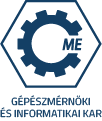| Course objectives: Introducing the fundamentals of gear mesh topic, presenting the Reaching Model Theory and Surface Constructor surface generator tool, additionally discussing some concrete applications in the area of gear mesh, toothing tool optimization and special enveloped surfaces development to achieve high level of understanding of gear mesh modeling and develop investigation and optimization capabilities of innovative gearing types. |
| |
| Course content and structure: |
| 1. Spatial point- transformations. Homogeneous coordinate transformation matrices, kinematic chains. Application for toothing machines, drive chains, robots. Fundamental differences between surfaces that are designed with well-known CAD systems or generated by enveloping. The main areas of application of enveloped surfaces:gear mesh, production of tooth surfaces, kinematic pairs of motion. The concept of conjugated surfaces. 2. Basic task of connection, solution methods: differential geometry method, kinematic method, reaching model. Contacting, meshing, local undercutting, global cut. 3. Realizing the reaching model in a 3D kinematic simulation program. The structure of the system: symbolic and numerical levels. 4. Generation of surface pairs with intermediary generating surface. Mesh in line and in point. Characteristic gearing types for line-like meshing. Characteristic tooth gearing types for point-like meshing. 5. Introduction to symbolic algebraic calculus. Determination of axoids, calculation and display of velocity, acceleration, motion paths, surface curvature relations. 6. Use of the R-F function to evaluate the goodness of the meshing. 7. Case studies to derive and optimize kinematic surface pairs with Surface Constructor CAD software: build a tooth surface (worm gear having elliptical profile);8. Tool surface derivation (grinding of globoid worms); 9. Simulation of teething (spiroid worm gear); application for mechanism design (control path design for cam mechanism); 10.Derivation of axoids in various specific kinematics; Special space objects.11.Double modified localised worm gearing;hypoid drive pairs generation with intermediary generating surface; 12.Cylindrical worm gearing with point-like mesh; 13.Generation of the main parts of a rotary internal combustion engine. |
| Evaluation method: Written test examination, 1-5 grades |
| |
| Required reading: 1. L. Dudás: New Way for the Innovation of Gear Types, in: Engineering the Future (Ed.: Laszlo Dudas) Chapter 6. https://www.intechopen.com/books/engineering-the-future/new-way-for-the-innovation-of-gear-types |
| |
| Suggested reading: 1. Faydor L. Litvin , Alfonso Fuentes: Gear Geometry and Applied Theory, Cambridge University Press, 2004. 2. Illés Dudás: The theory and practice of worm gear drives; Penton Press, 2000. 3. László Dudás: Possibilities of Exact Grinding of Conical and Globoid Worms, International Review of Mechanical Engineering (I.R.E.M.E.), Vol. 1 No. 3, pp. 200-207. 4. László Dudás: Advanced software tool for modelling and simulation of new gearings International Journal of Design Engineering IJDE Vol. 3. No.3, pp. 289-310. 5. Laszlo Dudas: Modelling and simulation of a new worm gear drive having point-like contact, Engineering with Computers, Engineering with Computers: Volume 29, Issue 3 (2013), pp. 251-272 |


